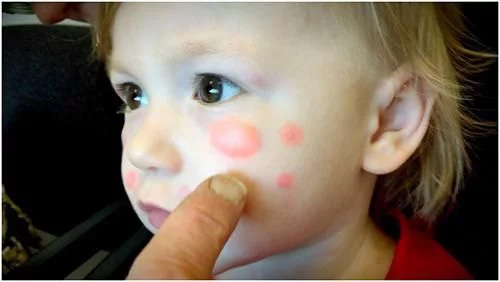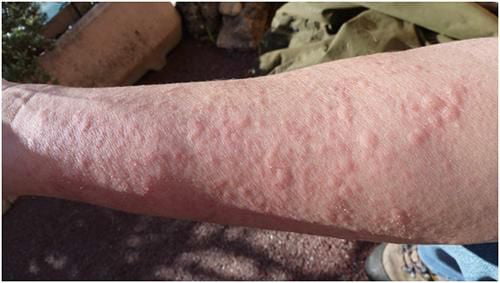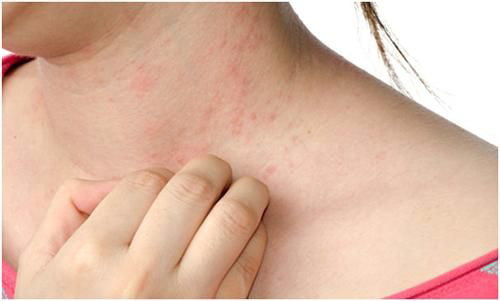Hives are an allergic skin reaction causing localized redness, swelling, and itching. It is a reaction of the body’s immune system that causes areas of the skin to swell, itch, and become reddened (wheals). When the reaction is limited to small areas of the skin, it is called “urticaria.” Involvement of larger areas, suchas whole sections of a limb, is called “angioedema.”
Symptoms
Urticaria is characterized by redness, swelling, and itching of small areas of the skin. These patches usually grow and recede in less than a day, but may be replaced by hives in other locations. Angioedema is characterized by more diffuse swelling. Swelling of the airways may cause wheezing and respiratory distress. In severe cases, airway obstruction may occur.
Causes
Hives is an allergic reaction. The body’s immune system is normally responsible for protection from foreign invaders. When it becomes sensitized to normally harmless substances, the resulting reaction is called an allergy.
An attack of hives is set off when such a substance, called an allergen, is ingested, inhaled, or otherwise contacted. It interacts with immune cells called mast cells, which reside in the skin, airways, and digestive system. When mast cells encounter an allergen, they release histamine and other chemicals, both locally and into the bloodstream.
These chemicals cause blood vessels to become more porous, allowing fluid to accumulate in tissue and leading to the swollen and reddish appearance of hives. Some of the chemicals released sensitize pain nerve endings, causing the affected area to become itchy and sensitive.
A wide variety of substances may cause hives in sensitive people, including foods, drugs, and insect bites or stings.
Common contributing factors to hives include:
- Nuts, especially peanuts, walnuts, and Brazil nuts
- Fish, mollusks, and shellfish
- Eggs
- Wheat
- Milk
- Strawberries
- Food additives and preservatives
- Penicillin or other antibiotics
- Flu vaccines
- Tetanus toxoid vaccine
- Gamma globulin
- Bee, wasp, and hornet stings
- Bites of mosquitoes, fleas, and scabies
How do dermatologists diagnose hives and administer hives treatment?

When a patient has hives on the skin, a dermatologist can often make the diagnosis by looking at the skin. Finding the cause of hives, however, can sometimes be hard. This is especially true for hives that have been around for more than six weeks.
To find out what is causing your hives, your dermatologist will review your health history, ask questions, and do a physical exam. You may need the following tests:
- Allergy tests (on the skin or blood tests).
- Blood work (to rule out an illness or infection).
- A skin biopsy
To perform a skin biopsy, the dermatologist removes a small piece of affected skin so that it can be examined under a microscope.
What Are Hives and How Is It Treated?
1. Hives Treatment
Mild cases of hives are treated with antihistamines, such as diphenhydramine (Benadryl) or desloratadine (Clarinex).Clarinex is non-sedating, meaning it will not make patients drowsy. More severe cases may require oral corticosteroids such as prednisone. Topical corticosteroids are not effective. Airway swelling may require emergency injection ofepinephrine (adrenaline).
For a mild or moderate case of hives, the most common hives treatment in Singapore is a non-sedating (does not cause drowsiness) antihistamine. Antihistamines relieve symptoms like itching.

If you have chronic hives, your dermatologist may prescribe an antihistamine. You should take this medicine every day to prevent hives from forming. There are many antihistamines on the market. Some make you drowsy, and some do not. No one antihistamine works for everyone.
Your dermatologist may combine an antihistamine with other medicines to control the hives. Other medicines that are prescribed for hives treatment include:
- Cortisones (for short-term use only because of side effects with long-term use).
- Dapsone, an antibacterial.
- Other medicines that fight inflammation (redness and swelling).
- Ask your dermatologist about possible side effects (health problems that can result from the medicines).
- For some cases of hives or angioedema, you may need an injection of epinephrine (shot of adrenaline).
2. Outcome
A hive often will go away in 24 hours or less, but bouts can last longer. A few people have chronic hives (lasting more than six weeks). Sometimes chronic hives go away on their own — often within a year. For others, hives can come and go for months or years.
3. Prevention
Preventing hives depends on avoiding the allergen causing them. Analysis of new items in the diet or new drugs taken may reveal the likely source of the reaction. Chronic hives may be aggravated by stress, caffeine, alcohol, or tobacco;avoiding these may reduce the frequency of reactions.

